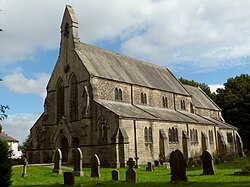Church of St Thomas the Apostle, Killinghall
| Church of St Thomas the Apostle, Killinghall | |
|---|---|
| St Thomas the Apostle Parish Church | |

St Thomas the Apostle, 2016
|
|
| 54°1′18″N 1°33′59″W / 54.02167°N 1.56639°WCoordinates: 54°1′18″N 1°33′59″W / 54.02167°N 1.56639°W | |
| OS grid reference | SE286584 |
| Location | Killinghall, North Yorkshire |
| Country | England |
| Denomination | Church of England |
| Churchmanship | Central |
| Website | stthomasabeckethampsthwaite |
| History | |
| Founded | 26 April 1879 |
| Dedication | Thomas the Apostle |
| Dedicated | 29 July 1880 |
| Consecrated | 29 July 1880 |
| Architecture | |
| Status | Parish church |
| Functional status | Active |
| Heritage designation | Unlisted |
| Architectural type | Parish church |
| Style | Gothic Revival architecture |
| Specifications | |
| Bells | 2 |
| Administration | |
| Parish | Ecclesiastical parish of Killinghall |
| Deanery | Harrogate (46503) |
| Archdeaconry | Richmond and Craven (465) |
| Diocese | Ripon and Leeds |
| Clergy | |
| Vicar(s) | The Revd Christella Helen Wilson |
| Laity | |
| Churchwarden(s) | Mr Robbie Walker, Mrs L. Reid, Mrs L. Dennis |
The Church of St Thomas the Apostle, Killinghall, is an Anglican parish church in Killinghall, North Yorkshire, England. It was designed in 1879 by William Swinden Barber when the parish of Ripley was split to create the additional parish of Killinghall, and a new building was required to accommodate a growing congregation. It was opened in 1880. Among the early vicars posted in this benefice were two canons, Sydney Robert Elliston and Lindsay Shorland-Ball, and the Venerable Robert Collier, an Irish missionary who served in India and Africa.
Before St Thomas' was built, the Anglicans of Killinghall were obliged to walk 1.2 miles (1.9 km) to Ripley church every Sunday, making attendance difficult for the elderly and infirm. In latter years the schoolroom at Killinghall was licensed for public worship, but as the Bishop of Ripon said, "There were not those influences about it which belonged to a consecrated building."
In the 1870s the village of Killinghall, in the parish of Ripley, was increasing in size, and by 1879 had a population of 6,200 who needed a church closer than the one at Ripley. Killinghall consequently became a separate parish. The endowment for this parish came from the sale of a glebe farm at Ripley. More than an acre of land for the church and its approaches was donated by Dr and Mrs Beaumont of Knaresborough, and donations were given by local landowners and friends of the project. This allowed the church committee to plan a vicarage also. Beaumont later agreed to sell the adjoining two acres of land to the committee for £200, and this was earmarked for the burial ground. The committee received a grant of £1,500 from the Ecclesiastical Commissioners, and expected to have to raise £3,000 for a church building to accommodate 400–500 persons, and £1,500 for the vicarage. However, in return for the vicarage grant, the new vicar Reverend R.K. Smith had to pay the Commissioners £214 per annum. This sum equalled the whole of his stipend, apart from the use of the vicarage which was not yet built. On Thursday, Friday and Saturday 28–30 August 1879, a bazaar was held under the auspices of Miss Ingilby of Ripley Castle, to raise over £300 towards the cost of the church. This event was designed to attract the gentry of Harrogate, who arrived in large numbers by carriage.
...
Wikipedia

